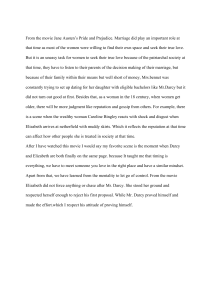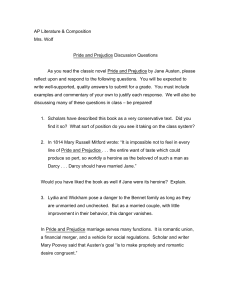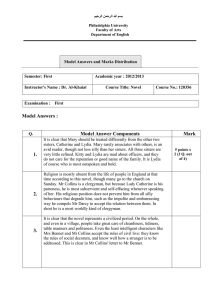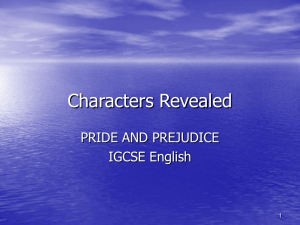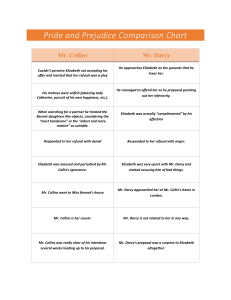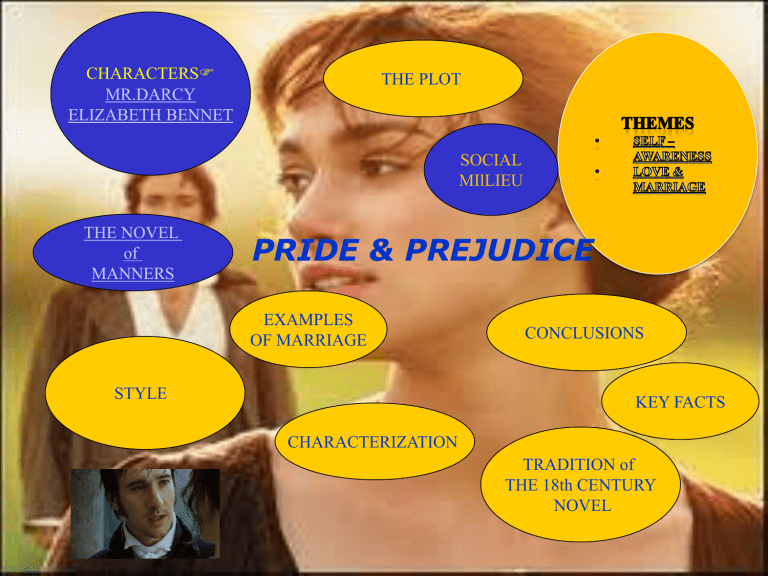
CHARACTERS MR.DARCY ELIZABETH BENNET THE PLOT SOCIAL MIlLIEU THE NOVEL of MANNERS PRIDE & PREJUDICE EXAMPLES OF MARRIAGE STYLE CONCLUSIONS KEY FACTS CHARACTERIZATION TRADITION of THE 18th CENTURY NOVEL TRADITION OF THE 18th CENTURY NOVEL Chronologically Jane Austen belonged to the Romantic period, but her realism and balance in novel construction place her in the line with the tradition of the 18th century novel. From Fielding (author) she derived the use of the third person omniscient narrator aand the technique of bringing the characters into existence through dialogue. From Richardson (author) she learned the insight into the psychology of the characters and the description of the ordinary events of life, like balls, walks, tea-parties and visits to friends. 2 THE SOCIAL MILIEU The social milieu of Austen’s England was particularly stratified, and class divisions were rooted in family connections and wealth. Austen is often critical of the assumptions and prejudices of upper-class England. She distinguishes between internal merit (goodness of person) and external merit (rank and possessions). Though she frequently satirizes snobs, she also pokes fun at the poor breeding and misbehavior of those lower on the social scale. She depicts one in which social mobility is limited and classconsciousness is strong. Austen was also concerned about appropriate behavior for each gender. While social advancement for young men lay in the military, church, or law, the chief method of self-improvement for women was the acquisition of wealth. Women could only accomplish this goal through the arrangement of a successful marriage, which explains the ubiquity of matrimony as a goal and topic of conversation in Austen’s writing. 29/06/2021 3 KEY FACTS • • • • • • • • • • • • • Key Facts · Pride and Prejudice AUTHOR · Jane Austen TYPE OF WORK · Novel GENRE · Comedy of manners; romance LANGUAGE · English TIME AND PLACE WRITTEN · England, between 1796 and 1813 DATE OF FIRST PUBLICATION · 1813 NARRATOR · Third-person omniscient CLIMAX · Mr. Darcy’s proposal to Elizabeth (Volume 3, Chapter 16) PROTAGONIST · Elizabeth Bennet ANTAGONIST · Snobbish classconsciousness (epitomized by Lady Catherine de Bourgh and Miss Bingley) SETTING (TIME) · Some point during the Napoleonic Wars (1797–1815) • SETTING (PLACE) · Longbourn, in rural England FULL TITLE • • • • • • 29/06/2021 • POINT OF VIEW · The novel is primarily told from Elizabeth Bennet’s point of view. FALLING ACTION · The two chapters of the novel after Darcy’s proposal TENSE · Past tense FORESHADOWING · The only notable example of foreshadowing occurs when Elizabeth visits Pemberley, Darcy’s estate, in Volume 3, Chapter 1. Her appreciation of the estate foreshadows her eventual realization of her love for its owner. TONE · Comic—or, in Jane Austen’s own words, “light and bright, and sparkling” THEMES (BASIC) & MOTIFS · Love; 4 Reputation; Class ,Courtship. CHARACTERIZATION Pride and Prejudice comes alive in the vividness of characters; in the brightness of dialogue, the narration of events is balanced by passages for reflection and by letters. the epistolary technique (a novel told through letters), derived from Richardson, is used more frequently in the later chapters of the novel rather than throughout the whole novel THE PLOT • • • • • The novel is set in Longbourn, a small country village in Hertfordshire, where Mr. and Mrs. Bennet live with their five daughters: Jane, Elizabeth, Mary, Lydia, and Kitty. One day a rich bachelor, Mr. Bingley and his two sisters rent a large estate in the neighborhood, called Netherfield Park. After a series of balls and parties that bring the members of this little society together, Mr. Bingley falls in love with Jane, and his friend, the aristocratic Fitzwilliam Darcy, begins to feel attracted to Elizabeth. BUT she dislikes him because when he does admit he loves her, he cannot help showing contempt for her inferior social position (namely her mother’s and younger sisters’s behavior). So Lizzie accuses him of being responsible for the separation between Mr. Bingley and Jane, and of ill-treating Mr. Wickham, a young officer who was the son of Darcy’s former steward. THE PLOT • After Lizzie’s refusal of him, Darcy writes a letter where he explains that Wickham was an unscrupolous gold-digger. • Meanwhile, Wickham elopes with Lydia; Darcy tracks them down and provides for their marriage to keep the Bennets out of scandal. • Elizabeth realizes that she was mistaken about Darcy and accepts his renewed proposal, in spite of the opposition of Lady Catherine de Bourgh, Darcy’s arrogant aunt. • Then Bingley comes back and gets engaged to Jane and so the novel ends with the happy marriages of the two 29/06/2021 couples. YAY!! THEME OF THE NOVEL THE MAIN THEME of the NOVEL is the journey towards selfawareness and selfknowledge. This theme is complemented by other themes, which are love, marriage, social status, and wealth. 8 LOVE & MARRIAGE ROMANTIC LOVE in Jane Austen is often in conflict with the social code which encourages marriages for money and social standing. However , she remained fully committed to the common sense and the moral principles of the previous generation. In other words her treatment of love and sexual attraction is in line with the general view that strong feelings and passions should be regulated , controlled, and brought to order by private reflection, to fulfill a social obligation. The heroine’s reflection after a crisis or climax is a usual feature. The happy ending is a common element in her novels: they all end in the marriage of a hero and a heroine. What makes them interesting is the concentration on the steps through which the protagonist reach marriage. 9 EXAMPLES OF MARRIAGE in P&P THE NOVEL OF MANNERS J.A.’s novels of manners are based on the premise that there is a vital relantionship between manners, social behavior, and character. They are usually set in the upper and middle levels of society, usually in the country with few insights into town. They deal with the codes and conventions of daily behavior. They present balls, teas, and visits as occasion for meeting. They explore personal relantionships, class distinctions, and their effect on characters’ behavior. They deal with the influence of money and property on the way people treat each other. The main themes are marriage and the complications of love and friendship within this social world. The use of the third person narrator. Dialogues play an important role because they reveal the characteristics of the characters. Irony is often employed. 29/06/2021 RESOLUTIONS As it often happens in Jane Austen’s novels, a letter will be the turning point in the hero/heroine relationship. Darcy writes to Elizabeth and a journey of selfrealization will start for her. After Darcy's explanation Jane Austen writes that Elizabeth … “ …grew absolutely ashamed of herself, - of neither Darcy nor Wickham could she think, without feeling that she had been blind, partial, prejudiced , absurd”. “Till this moment, I never knew myself”, Elizabeth thinks. This is why Jane Austen titled this novel “First Impressions” at first. Elizabeth's first impression of Darcy was completely wrong. She has been too proud and too impulsive and this caused her misjudgement. What else will Elizabeth discover about Darcy which will make her radically change her opinion of him? She will travel in Derbyshire with Mr. /Mrs. Gardiner and visit Darcy’s residence at Pemberley (she is amazed at its grandeur) and will hear about Mr. Darcy ‘s inestimable virtues from Mrs. Reynolds, his house-keeper. When she receives the news that Lydia, her 15-year-old sister, has eloped with Mr.Wickham, Elizabeth is terribly embarrassed , especially because she has to tell Darcy what has happened. But she will, instead, discover later that he worked hard behind the scenes to help the Bennet family to avoid scandal: he arranged for Wickham to marry Lydia publically and paid for all the expenses. Finally, Elizabeth will see her sister happy: Darcy encourages Bingley to return to Longbourn again and to renew his courtship of Jane. Now apologies and explanations can be given and Darcy can renew his own proposal…The question remains: Will Elizabeth accept it this time? STYLE • • • Irony is much employed as a technique in relation to the characters who are trapped in a double perspective: they don’t know that things are not the way they seem, but the reader does. Jane Austen employs third-person narration and positions herself close to the mind of one character - mainly Elizabeth - and presents the action from her point of view. The first person narrative also plays a part in the novel by means of many letters. ELIZABETH BENNET ELIZABETH BENNET Similarly to Mr. Darcy, Elizabeth possesses great qualities, but also great weaknesses. She has a lively mind which permits her to have complex impressions and ideas; She has a strong spirit of independence: she refuses to take on the roles which her family or socially superior people try to impose upon her. Both Elizabeth and Mr. Darcy set out with an imperfect understanding of each other. She accuses him of pride and he accuses her of prejudices. But the true is also reverse: she is proud and her pride blinds her to his virtues; He is prejudiced because of his social class and so he is disgusted by the vulgar behaviors of Mrs. Bennet and the younger sisters who are quite frivolous. MR.DARCY MR. DARCY The son of a wealthy, well-established aristocratic family and the master of the great estate of Pemberley, Darcy is Elizabeth’s male counterpart in the novel. He has great qualities, but also great weaknesses. He is selfish and unsocialable. He tends to judge too hastily and harshly, and his high birth and wealth make him overly proud and overly conscious of his social status. However, he is intelligent and forthright. He demonstrates his continued devotion to Elizabeth, in spite of his distaste for her low connections, when he rescues Lydia and the entire Bennet family from disgrace, and when he goes against the wishes of his haughty aunt, Lady Catherine de Bourgh, by continuing to pursue Elizabeth. Darcy proves himself worthy of Elizabeth, and she ends up retracting her earlier, harsh judgment of him.
